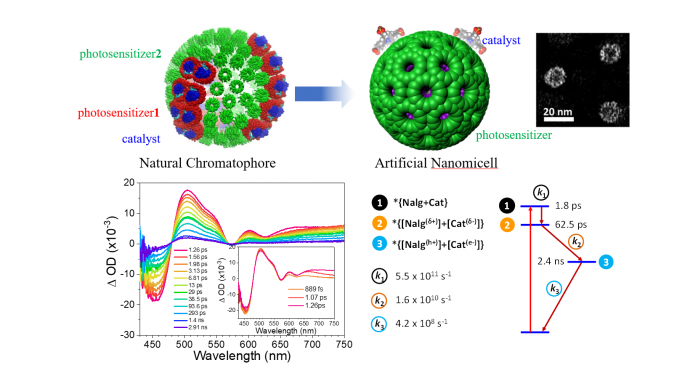Media
Potentially Producing Carbon-Neutral Fuels:
HKU Chemists Achieve Sustainable Solar Energy Conversion with Artificial Photocatalysis
07 Jun 2023
Converting solar energy into carbon-neutral fuels is a promising approach to reduce our dependence on fossil fuels and combat climate change. Taking examples from nature, plants and other photosynthetic organisms use sunlight to create energy-rich compounds from water and carbon dioxide (CO2) through a complex biochemical process that take places within specialised structures called chloroplasts. However, the efficiency of this natural process is limited by metabolic pathway that have a reflectively low effectiveness in converting sunlight into useful energy. While artificial photocatalytic cycles have demonstrated higher intrinsic efficiencies, they typically rely on pure or highly concentrated CO2 and organic media to prevent degradation of the catalyst caused by water or protons.
Research teams led by Professor David Lee PHILLIPS from the Department of Chemistry of The University of Hong Kong (HKU), Professor Lili DU at Jiangsu University (HKU PhD Alumna), Professor Ruquan YE at the City University of Hong Kong and Professor Jia TIAN at the Shanghai Institute of Organic Chemistry have developed a remarkable and environmentally friendly system that can effectively harness light energy for the photocatalytic process. This artificial system is highly-stable and recyclable, and it does not rely on precious metals, making it more economically viable and sustainable. The research findings are recently published online in the top scientific journal Nature Catalysis.
Background and Achievement
In nature, organisms use a process called ‘hierarchical self-assembly’ to optimise light harvesting. During the process, they organise photocatalytic components within a tailored environment provided by lipid or protein-based scaffolds. By achieving high stability, selectivity, and efficiency, photosynthesis relies on the high surface area and precise spatial control of chromophore molecules and catalytic centres through self-assembly, which offers a design principle for highly efficient artificial photocatalytic systems.
Recent studies have demonstrated using vesicles and micelles formed by co-assembly of natural lipids or synthetic surfactants with photocatalytic species. These structures act as micro-reactors, mimicking the environment of cell membranes. However, replicating the natural light-harvesting super complexes via synthetic pathways is hard to implement and far from cost-effective.
With full appreciation for the current efforts and the challenges, the HKU team and their collaborators have designed a self-assembling artificial spherical chromatophore nanomicelle system in water inspired by the photosynthetic apparatus of Rhodobacter sphaeroides, a type of bacteria that is commonly found in soil and freshwater, which has a special structure called ‘spherical light-harvesting chromatophore’. This structure acts as a light sensor and possesses a remarkable ability to efficiently transfer energy from sunlight via a unique effect called ‘the spherical antenna effect’, created by circular arrangements of specific molecules on the surface of the chromatophore. This allows the bacteria to capture and utilise sunlight effectively for their energy needs.
This artificial system mimics the bacteria's spherical light harvesting chromatophore and comsists of tiny spherical structures called nanomicelles that are self-assembled in aqueous solutions. These nanomicelles serve as the building blocks of the system. The system utilises modified molecules and light-absorbing compounds known as ‘aramid-linker enhanced Zn porphyrin amphiphiles’, which interact with a Co catalyst through electrostatic forces, leading to a unique hierarchical assembly. Hence, this assembly is induced by ‘spherical antenna effect’, and enhances the system to capture and alight energy for photocatalytic processes.
The hierarchical self-assembly of the system offers a promising bottom-up strategy to create a precisely controlled artificial photocatalytic system with high stability and efficiency based on cheap and Earth-abundant elements rather than expensive precious metals.
Professor David Phillips said: "Our research has the potential to advance renewable energy by replicating nature's efficient light-harvesting mechanisms. This could lead to sustainable solutions for our energy needs and the production of carbon-neutral fuels, contributing to a greener future."
Professor Lili Du said: "The self-assembling artificial system is a significant step towards unlocking the full potential of solar energy conversion. Improving photocatalytic efficiency and stability can overcome limitations and create a cleaner, more sustainable energy landscape. This research offers promising practical applications in fuel production, carbon capture, and environmental remediation."
About Professor David Lee Phillips
Professor David Lee Phillips is a Chair Professor in the HKU Department of Chemistry. As an internationally recognised chemist, he uses time-resolved spectroscopy experiments and quantum mechanical calculations to study short-lived intermediates in chemical reactions of interest in chemistry, biology and the environment. He has published more than 400 internationally refereed scientific journal articles listed in Science Citation Index. He serves on the Editorial Advisory Board of the journal Molecules and also on the Advisory Board of the Journal of Physical Organic Chemistry. Professor Phillips graduated with a BSc from Iowa State University and with a PhD from the University of California, Irvine. More information about his research group: https://sites.google.com/view/dlplab/home?pli=1
About the Research Team
Professor Jia Tian from the Shanghai Institute of Organic Chemistry, Professor Lili Du from Jiangsu University, Professor David Lee Phillips from the University of Hong Kong and Assistant Professor Ruquan Ye from City University of Hong Kong are the co-corresponding authors. Mr Junlai Yu and Libei Huang from Professor Tian’s Group are the co-first authors. Professor Ian Manners from the University of Victoria and other researchers (including Qingxuan Tang, Shang-Bo Yu, Qiao-Yan Qi, Jiangshan Zhang, Danying Ma, Yifei Lei, Jianjun Su, Yun Song, Jean-Charles Eloi, Robert L. Harniman, Ufuk Borucu, Long Zhang, Minghui Zhu, Feng Tian) from Shanghai Institute of Organic Chemistry and University of Victoria contribute to this project.
Journal title: ‘Artificial spherical chromatophore nanomicelles for selective CO2 reduction in water’ (Nature Catalysis , 2023)
The journal paper can be accessed here: https://www.nature.com/articles/s41929-023-00962-z#citeas
Image download and caption: https://www.scifac.hku.hk/press
For media enquiries, please contact Ms Casey To, External Relations Officer (Tel: 3917-4948; email: caseyto@hku.hk) and Ms Cindy Chan, Assistant Communications Director of Faculty of Science (Tel: 3917- 5286; email: cindycst@hku.hk).

